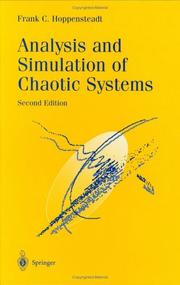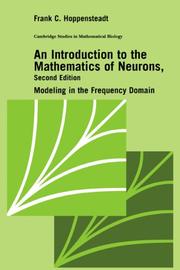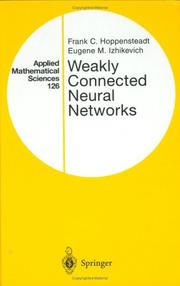| Listing 1 - 10 of 17 | << page >> |
Sort by
|
Book
ISBN: 0387979166 147572277X 1475722753 9780387979168 Year: 1993 Volume: 94 Publisher: New York (N.Y.): Springer,
Abstract | Keywords | Export | Availability | Bookmark
 Loading...
Loading...Choose an application
- Reference Manager
- EndNote
- RefWorks (Direct export to RefWorks)
Book
ISBN: 3540979166 Year: 1993 Publisher: London Springer
Abstract | Keywords | Export | Availability | Bookmark
 Loading...
Loading...Choose an application
- Reference Manager
- EndNote
- RefWorks (Direct export to RefWorks)

ISBN: 1280010754 9786610010752 0387226982 0387989439 Year: 2000 Publisher: New York, NY : Springer New York : Imprint: Springer,
Abstract | Keywords | Export | Availability | Bookmark
 Loading...
Loading...Choose an application
- Reference Manager
- EndNote
- RefWorks (Direct export to RefWorks)
Beginning with realistic mathematical or verbal models of physical or biological phenomena, the author derives tractable mathematical models that are amenable to further mathematical analysis or to elucidating computer simulations. For the most part, derivations are based on perturbation methods. Because of this, the majority of the text is devoted to careful derivations of implicit function theorems, the method of averaging, and quasi-static state approximation methods. The duality between stability and perturbation is developed and used, relying heavily on the concept of stability under persistent disturbances. This explains why stability results developed for quite simple problems are often useful for more complicated, even chaotic, ones. Relevant topics about linear systems, nonlinear oscillations, and stability methods for difference, differential-delay, integro- differential and ordinary and partial differential equations are developed throughout the book. For the second edition, the author has restructured the chapters, placing special emphasis on introductory materials in Chapters 1 and 2 as distinct from presentation materials in Chapters 3 through 8. In addition, more material on bifurcations from the point of view of canonical models, sections on randomly perturbed systems, and several new computer simulations have been added.
Chaotic behavior in systems. --- Global analysis (Mathematics). --- Ecology. --- Analysis. --- Mathematical and Computational Biology. --- Mathematical analysis. --- Analysis (Mathematics). --- Biomathematics. --- Ecology . --- Balance of nature --- Biology --- Bionomics --- Ecological processes --- Ecological science --- Ecological sciences --- Environment --- Environmental biology --- Oecology --- Environmental sciences --- Population biology --- Mathematics --- 517.1 Mathematical analysis --- Mathematical analysis --- Ecology
Book
ISBN: 0521305667 Year: 1986 Publisher: Cambridge Cambridge University Press
Abstract | Keywords | Export | Availability | Bookmark
 Loading...
Loading...Choose an application
- Reference Manager
- EndNote
- RefWorks (Direct export to RefWorks)
Book
Year: 1975 Volume: 20 Publisher: Philadelphia : Society for Industrial and Applied Mathematics,
Abstract | Keywords | Export | Availability | Bookmark
 Loading...
Loading...Choose an application
- Reference Manager
- EndNote
- RefWorks (Direct export to RefWorks)
Population biology --- Genetics --- Epidemics --- Biologie des populations --- Génétique --- Mathematical models --- Mathematical models. --- Modèles mathématiques

ISBN: 0521599296 0521590752 Year: 1997 Publisher: Cambridge : Cambridge university press,
Abstract | Keywords | Export | Availability | Bookmark
 Loading...
Loading...Choose an application
- Reference Manager
- EndNote
- RefWorks (Direct export to RefWorks)
This book describes the signal processing aspects of neural networks. It begins with a presentation of the necessary background material in electronic circuits, mathematical modeling and analysis, signal processing, and neurosciences, and then proceeds to applications. These applications include small networks of neurons, such as those used in control of warm-up and flight in moths and control of respiration during exercise in humans. Next, a theory of mnemonic surfaces is developed and studied and material on pattern formation and cellular automata is presented. Finally, large networks are studied, such as the thalamus-reticular complex circuit, believed to be involved in focusing attention, and the development of connections in the visual cortex. Additional material is also provided about nonlinear wave propagation in networks. This book will serve as an excellent text for advanced undergraduates and graduates in the physical sciences, mathematics, engineering, medicine and life sciences.
Neural circuitry --- Neurons --- Mathematical models --- Mathematical models.
Article
Abstract | Keywords | Export | Availability | Bookmark
 Loading...
Loading...Choose an application
- Reference Manager
- EndNote
- RefWorks (Direct export to RefWorks)
Book
Year: 1975 Publisher: Philadelphia : Society for Industrial and Applied Mathematics,
Abstract | Keywords | Export | Availability | Bookmark
 Loading...
Loading...Choose an application
- Reference Manager
- EndNote
- RefWorks (Direct export to RefWorks)
Démographie --- Demography. --- Genetique des populations --- Dynamique des populations
Article
Abstract | Keywords | Export | Availability | Bookmark
 Loading...
Loading...Choose an application
- Reference Manager
- EndNote
- RefWorks (Direct export to RefWorks)

ISBN: 0387949488 9780387949482 Year: 1997 Volume: 126 Publisher: New York: Springer,
Abstract | Keywords | Export | Availability | Bookmark
 Loading...
Loading...Choose an application
- Reference Manager
- EndNote
- RefWorks (Direct export to RefWorks)
This book is devoted to local and global analysis of weakly connected systems with applications to neurosciences. Using bifurcation theory and canonical models as the major tools of analysis, it presents systematic and well motivated development of both weakly connected system theory and mathematical neuroscience. Bifurcations in neuron and brain dynamics, synaptic organizations of the brain, and the nature of neural codes are among the many important issues addressed. The authors offer the reader classical results as well as some of the most recent developments in the field. The book will be useful to researchers and graduate students in various branches of mathematical neuroscience.
| Listing 1 - 10 of 17 | << page >> |
Sort by
|

 Search
Search Feedback
Feedback About UniCat
About UniCat  Help
Help News
News